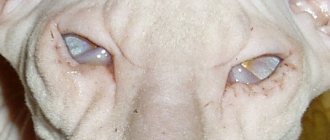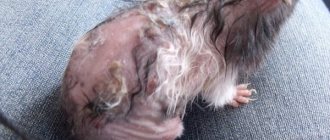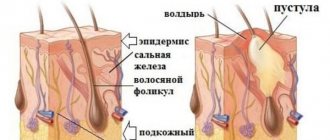13.06.2019
Skin diseases in cats
no comments
5165
Ever since cats became the most popular pets, there seems to be a constant rise in dermatological diseases. One of the common skin diseases, the treatment of which we will look at in this article, is atopic dermatitis .
Statistics show that most individuals with atopy are orange or partly orange (that is, tri-colored or tortoiseshell). Of course, there are different colors, but most atopic cats are orange in color.
Purebred and purebred pets are also more prone to atopy. Allergic atopic dermatitis in cats does not have classic signs, unlike dogs. Therefore, it is necessary to exclude several differential diagnoses before making a diagnosis.
What causes dermatitis in cats?
This pathological condition in both an adult cat and a kitten can develop due to:
- decreased immunity;
- hormonal disorders;
- endocrine diseases;
- feeding on low-quality, cheap food, which contains a lot of artificial additives;
- the presence of worms, fleas, ticks, and other parasites in the body;
- treatment with certain medications;
- burns, injuries that violate the integrity of the skin;
- bacterial infections.
Thus, feline dermatitis is not an independent disease, but a consequence of certain problems related to the pet’s health.
Risk group and causes of development
According to the experience of veterinarians, dermatitis most often bothers domestic cats. Outbreaks of the disease occur during the warm season, during the period of insect activity, more frequent walks and water procedures. However, even in cold weather, the skin of animals can be very sensitive, which provokes inflammation and rashes.
The disease affects pets of any gender and breed. Kittens rarely suffer from dermatitis, but they tolerate it worse and may die. From the age of 1 year, the risk of developing this disease increases. You should especially carefully monitor the skin condition of pets in conditions of decreased immunity after vaccination, surgery or any disease.
The main causes of dermatitis in cats:
- hormonal imbalance;
- drop in immune defense;
- activity of opportunistic yeast fungi (Malassezia form);
- endocrine pathologies (for example diabetes);
- diseases of the digestive system;
- injuries, skin burns;
- low-quality ready-made food (causes atopic form);
- parasites (fleas, helminths, ticks);
- bacterial infection in the body;
- taking certain medications;
- change of environment, climate zone when moving.
Types of dermatitis in cats
Fungal dermatitis
Depending on the causes, different types of dermatitis are distinguished. Parasitic occurs when an animal has external or internal parasites (fleas, ticks, helminths). Under the influence of saliva or waste products, itching and irritation may occur.
Allergic dermatitis in cats can be caused by poor quality food or its components. Allergens include medications, pollen, and environmental pollution. It is possible to develop contact, which appears when interacting with aggressive substances. Its second type is atopic, which is an inadequate response of the immune system to certain types of allergens. In most cases, it appears in cats whose skin is very sensitive and prone to inflammation and rashes.
The cause of bacterial and fungal dermatitis is pathogenic microflora (streptococci, staphylococci, etc.). It is possible to develop seborrheic, which causes dandruff.
Various injuries lead to the development of traumatic dermatitis, for example, if the collar injures the cat’s skin or the cat is bitten by another animal.
Contact with household chemicals and cosmetics leads to the appearance of chemicals.
Atopic dermatitis
general information
The term “dermatitis” hides many diseases of various etiologies. But these diseases have something in common - skin manifestations. According to the nature of the symptoms, dermatitis can be:
superficial. mild itching, slight redness or rash;
purulent. Ulcers, severe scratching, clearly noticeable inflammation (secondary infection due to the development of pathogenic bacteria on the affected skin);
wet. With weeping dermatitis, the skin seems to be torn off, oozing ichor or pus, and the hair around the wound falls out.
The photo below shows typical wet areas:
The general signs of dermatitis, regardless of the cause of the disease, are typical and easily recognizable:
rash, scratching;
redness, inflammation;
swelling, blisters, blisters, ulcers;
extreme dry skin, scales, cracks. Or vice versa, damp hairless areas;
the skin is hot to the touch, the pet constantly feels itching and burning.
What dermatitis looks like in a particular case depends on the cat's individual reactions. Two pets with the same diagnosis may feel differently: one cat is only slightly itchy, while the second is going bald and bleeding. According to the nature of the disease, this disease can be acute, subacute and chronic. If your pet is treated incorrectly, acute dermatitis can develop into a chronic form - the symptoms will disappear for a while or become less noticeable, but will appear in all their glory during relapses. Chronic, indolent dermatitis is more difficult to deal with, so even barely noticeable dermatitis in cats on the ears is a reason to take your pet to the veterinarian.
Symptoms of the disease
The symptoms of all types of pathology are similar:
- a rash appears on the skin;
- the animal constantly scratches the sore spots;
- local redness is observed;
- the affected areas become inflamed and swollen;
- blisters may appear;
- hair falls out;
- scales form on dry areas;
- the appearance of ulcers and cracks is noted;
- The temperature in the affected areas rises.
The development of weeping dermatitis is accompanied by the appearance of moist, inflamed areas. To make sure whether the cat really has this pathology, you can compare the appearance of the lesions with photos that can be found on the Internet.
In general, the condition of a pet will depend on its individual ability to tolerate the disease.
Are cat dermatological diseases dangerous for humans?
Cat dermatitis itself is not dangerous to humans.
Only diseases that are accompanied by skin lesions, such as ringworm or fleas, can be contagious.
However, even in these cases, compliance with sanitary rules (handling the animal with gloves, washing hands after contact with the pet) will avoid possible infection.
The degree of danger depends on whether the fungus (or bacteria) is common to cats and humans
Differential diagnoses
The difficulty of making a diagnosis, especially in atopic cases, is due to the fact that in this case there is practically no unique picture of the development of the disease. For example, in some individuals, hair may fall out due to injury, while in others, crusts form at the site of scratching. It is also possible to develop external otitis, miliary dermatitis and other clinical symptoms.
Dandruff in cats with seborrheic dermatitis
Differential diagnoses in cats can be primary or secondary.
In the first case, we are talking about hypersensitivity to flea saliva, food allergies, allergic reactions to insects, demodicosis, dermatophytosis, otodectosis, and psychogenic alopecia.
In the second case, this applies to external, otitis media, pyoderma (superficial or deep), Malassezia dermatitis.
Operating principle
Lecaderm has anti-inflammatory, antiallergic and antifungal effects. Triple action is the result of combining three components that successfully complement each other:
- Betamethasone
dipropionate is a synthetic corticosteroid. The hormonal substance has a pronounced anti-inflammatory effect, as it suppresses the synthesis of substances that are involved in inflammatory processes. In addition, the substance constricts blood vessels, eliminates itching and redness. Effectively suppresses the manifestation of allergic reactions due to its effect on the immune system, reduces the permeability of vascular walls. - Gentamicin
is a broad-spectrum antibiotic. It copes with the destruction of gram-positive and gram-negative bacteria, including streptococci, staphylococci, Proteus, Pseudomonas aeruginosa and Escherichia coli. Equally effective for primary and secondary infections. - Clotrimazole
has an antifungal effect. It prevents the development of fungal infections caused by candida, mycosporum, trichophyton and other types of pathogenic fungi.
In general, the drug is considered safe for animals, but since it contains a hormonal substance, it is necessary to consult a doctor before use.
Diagnostics
As a rule, the most difficult thing is not to make a diagnosis based on a number of signs, but to find the cause of its occurrence. To determine it, a number of procedures are carried out. First, you need to make sure that your pet does not have parasites - fleas, ticks, worms. Secondly, you need to examine the inflammation itself, determine its nature - fungal or bacterial. To do this, smears are taken from the affected areas and a microscopic examination is carried out. Allergy tests are done to determine the reaction of the cat's body to various types of allergens. It is mandatory to take blood and urine tests, and test for the presence of viral infections. Sometimes an ultrasound examination and biopsy are performed.
Medicines for dermatitis
Flea dermatitis
Flea allergy dermatitis is often confused with the presence of parasites in a pet. However, one or a few bites is enough to trigger an allergy in a domestic cat that is not infested with fleas. The bite causes the skin to scratch. The animal literally tears itself with its paws until it bleeds. This is because the flea transfers the allergen into the cat’s blood using its saliva.
Symptoms still remain the same:
- Itching;
- Bloody scratches;
- Aggressive or depressed mood (depending on the character of the cat).
Treatment of flea dermatitis
Flea dermatitis should be treated with antiparasitic agents. These can be the usual collars, drops, sprays and shampoos. The only difference is that they need to be used much more often. In parallel, during therapy you should use ointments and antihistamines prescribed by your veterinarian.
© shutterstock
Treatment methods
The disease can only be treated in a complex manner. It is necessary to determine what caused the development of the pathology, to remove the factor that provoked its appearance. For therapy, special medications are used to help get rid of symptoms. The selection of drugs for the treatment of dermatitis in cats depends on the type of disease.
If the situation is advanced, the animal has to be taken to a veterinary clinic, where it is given IV drips.
Eliminate root causes
If the reason is poor-quality food, it must be replaced. Veterinarians recommend choosing a hypoallergenic option. To boost immunity, your veterinarian may recommend taking vitamins and herbs.
You cannot feed your cat whole milk, but it is recommended to diversify the diet with kefir, sour cream, cottage cheese and other fermented milk products. The menu should have enough fiber, cooked meat and grains.
You should not give your cat only dry food, as there will be a lack of vitamins and other nutrients.
When contact dermatitis develops, it is necessary to remove from the accessible area all substances that can harm the pet and minimize the use of household chemicals and repellents.
If it is parasitic, it is necessary to carry out treatment to remove fleas, ticks or helminths.
Flea dermatitis
Symptoms of an allergic skin reaction to flea bites
Signs that your cat is suffering from flea dermatitis:
Itching. Unlike people, a cat cannot complain of itching, so you can only suspect a problem by carefully observing your pet. Cats who are allergic to fleas incessantly scratch, lick and chew bites on their skin. Licking for dermatitis differs from the usual washing procedure typical of cats. Their behavior becomes restless, the animal literally cannot sit still for a second.
- Hair loss. It is caused by both intense licking and a local inflammatory process that weakens the hair follicles. Typical areas of baldness for flea dermatitis: sacral area, base of the tail, lateral and inner thighs, abdomen, neck and head (see photo).
- Numerous small scabs on the head and neck area. Due to their resemblance to millet grains, they are called miliary.
- Redness of the skin in bald areas and under the fur, scratches, abrasions in places where scratching is occurred. When the wounds dry out, they become covered with crusts called scabs.
- Papular eruptions. The rash looks like red spots that rise slightly above the level of the skin.
- Secondary infection. May be bacterial or fungal. In this case, you can notice suppuration in places where you scratched, the transformation of papules into pustules with purulent contents. Poorly healing wounds form in some areas.
When you part the fur, you can see live fleas and dark small grains of their excrement on the skin. Fleas love to hide in the armpits, on the inside of the thighs, on the neck and under the muzzle.
Small insects are easiest to see in areas with white or light fur; they are more difficult to spot against a dark background. You can verify the presence of fleas by brushing the cat while standing on a sheet of damp white paper. Dark lumps of flea secretions fall onto the paper, and a reddish halo blurs around them, representing the cat's undigested blood.
Many of the listed symptoms are not specific and may occur with other types of skin diseases. For a more detailed examination, you should contact a veterinary clinic.
Symptomatic therapy
In some cases, medications are added to the diet. Only a veterinarian can determine how to treat dermatitis in cats.
You can help with antihistamines (Tavegil, Suprastin, Zodak and others). The amount of medication must be determined by a veterinarian. These drugs relieve itching. But they only relieve the symptoms, not the cause.
In advanced cases, they are treated with glucocorticosteroid drugs - Prednisolone, Hydrocortisone and others. These ointments are applied to the affected areas daily. They help get rid of swelling, inflammation and itching. It is necessary to wear a blanket or veterinary collar to prevent the cat from licking the ointment.
It is possible to prescribe veterinary medications that reduce unpleasant symptoms and speed up healing.
To treat simple and traumatic dermatitis, healing ointments, creams and solutions are used. Treatment with iodine, Chlorhexidine and Miramistin is allowed. The last two drugs help reduce inflammation, get rid of pathogenic microflora and speed up healing. They are applied to damaged areas three times a day. Only the skin around the lesion can be treated with iodine to prevent the infection from spreading further.
Regenerating agents are used to treat contact. This could be, for example, zinc ointment; it dries the skin well and promotes rapid tissue restoration. The ointment is applied twice a day.
Salicylic ointment is an antiseptic and anti-inflammatory agent. Apply twice daily to affected areas. Treatment may take up to two weeks.
Several medications are used to treat flea dermatitis. First, the animal must be rid of parasites. This problem can be dealt with using drops that are applied to the withers, aerosols, sprays and special shampoos. According to veterinarians. It is better to use drops. The most popular products are Advantage, Bars and Dana. It is enough to apply the product once. In rare cases, the procedure is repeated after a month. When treating with sprays and aerosols, you need to cover the cat's head so that the drug does not get on it. For this purpose, use a veterinary cone.
Veterinary collar prevents the cat from licking the ointment
When the parasites are removed, you can proceed to treatment with anti-inflammatory and wound-healing drugs. If the disease is caused by bacteria, the doctor prescribes antibiotics - Amoxicillin, Azithromycin, Terramycin, etc. The course of treatment lasts from seven to ten days. The dosage is determined by the veterinarian. Erythromycin, tetracycline and other antibacterial ointments are used as a local remedy. Combination treatment will be effective when tablets and topical agents are prescribed.
Antibiotics can be given only after all the necessary tests. Otherwise you can only do harm. Firstly, such drugs reduce immunity, and secondly, they have side effects that can negatively affect the cat’s health. Salicylic ointment is an antiseptic and anti-inflammatory agent. Its use is possible only when it is known what exactly caused the dermatitis. Apply twice daily to affected areas. Treatment can last up to two weeks.
Several medications are used to treat flea dermatitis. First, the animal must be rid of parasites. This problem can be dealt with using drops that are applied to the withers, aerosols, sprays and special shampoos. According to veterinarians. It is best to use drops. The most popular products are Advantage, Bars and Dana. It is enough to apply the product once. In rare cases, the procedure is repeated after a month. When using sprays and aerosols, be sure to cover the cat's head so that the drug does not get on it. As a rule, a veterinary cone is used for this purpose.
When the parasites are removed, you can proceed to treatment with anti-inflammatory and wound-healing drugs. If the disease is caused by bacteria, the doctor will prescribe antibiotics. Treatment with Amoxicillin, Azithromycin, Terramycin, etc. is allowed. The course of treatment lasts from seven to ten days. The dosage is determined by the veterinarian. Erythromycin, tetracycline and other antibacterial ointments are used as a local remedy. Combination treatment is considered the most effective, when tablets and topical agents are prescribed.
Antibiotics should only be given if all necessary tests have been carried out and the veterinarian has confirmed the need for them. Otherwise, you can only harm your pet. Firstly, such drugs reduce immunity, and secondly, they have side effects that can negatively affect the cat’s health.
You need to feed your cat high-quality or special food
Caring for a sick pet
Caring for a sick pet is not very difficult. It is necessary to follow all the recommendations of the attending physician, such as washing with special shampoos, treating affected areas of the skin with antiseptic solutions and ointments, and using medications internally. You should come for repeat examinations on time to assess the dynamics of treatment, since all animals are individual and even with the same diagnosis, the approach to treatment will differ.
Predictions and prevention
Full recovery is possible, but each case is individual. In some cases, the disease goes away, in others, relapses may occur or the disease becomes chronic.
To keep your cat healthy, veterinarians recommend a number of preventive measures:
- your pet should be given only special high-quality food;
- nutrition must be balanced; in addition to dry food, other products must be added to the diet;
- a pet needs to be bathed approximately once every six months; if the cat goes outside, the interval between water procedures is reduced;
- give anthelmintic drugs once every three months;
- do not self-medicate and do not give medications that have not been prescribed by a veterinarian;
- use a flea collar;
- do not forget about vitamins and cat grass, which contains fiber;
- carry out vaccination.
It is recommended to conduct periodic examinations in order to detect symptoms of pathology in time.
When to use
Lecaderm is prescribed to cats for the treatment of the following diseases:
- for eczema;
- for allergic dermatitis;
- for dermatophytosis caused by fungal infections;
- with atopic dermatitis;
- for bacterial inflammation of the skin.
Often the drug is used for dermatitis, which is accompanied by a secondary infection. In this case, the medicine works on “two fronts” - it stops the progression of the underlying pathology and eliminates the inflammatory disease. If Lecaderm is used to treat allergic dermatitis, then it is additionally necessary to eliminate the cause of the allergy - protect the animal from insects, adjust nutrition, etc.
Owner reviews
Ekaterina, owner of a 4-year-old cat:
“Our cat periodically brings home fleas and begins to itch a lot. Only Lecaderm saves us from scratching. First we poison the fleas, and then use the ointment for a couple of days. The itching usually goes away on the second day, and after 3-4 days the skin is completely restored. The product may not be the cheapest, but it works great. A tube of ointment is always in the first aid kit.”
Olga, owner of a 7-year-old cat:
“Our cat suffers from food allergies. When introducing a new food, at first he feels normal, but after 1-2 months he begins to itch very much. Scratching straight to the point of bleeding. We tried a bunch of medications, but the cat continued to itch until the vet recommended Lecaderm. In just a couple of days the symptoms will begin to go away. Nowadays there is always this drug in the medicine cabinet. As soon as an allergy begins, we immediately use this ointment. Works great every time."
The structure of animal skin
The skin is the largest organ of a cat, the weight of which, depending on the species, age, and nutrition of the animal, ranges from 12 to 24% of its weight. It protects internal organs from the negative effects of the external environment, regulates body temperature, acts as an organ of touch, and performs other important functions.
The skin of a cat consists of three layers:
- epidermis;
- dermis;
- subcutaneous tissue.
Epidermis
The outer layer of the skin is the epidermis, consisting of keratinized scales. It is constantly updated. The scales leave the body when they are pushed out by young cells coming from below (the process of keratinization).
The layer is durable, elastic, capable of retaining water, salts, nutrients, and preventing infection from entering the body. There are also cells associated with whiskers and hair follicles that improve the sense of touch.
It is the epidermis that is damaged more often than others. With weak immunity, he may succumb to infection and sunlight. Fleas and ticks attack him first, gnawing holes.
basement membrane
The epidermis is separated from the next layer, the dermis, by a thin basement membrane. It is involved in cell regeneration and affects their metabolism. The elasticity of the cover depends on its integrity. Some diseases of the epidermis, as well as a number of autoimmune skin diseases of cats and dogs, can damage the membrane and disrupt its functions.
Dermis
The dermis produces collagen, which maintains skin tone. Also here is:
- A network of blood vessels through which the dermis nourishes the epidermis, fur, claws, and regulates body temperature.
- Sensory and motor nerves through which the body reacts to cold, heat, itching, pain.
- Immune cells that trap infectious agents that have been able to pass through the epidermis.
Subcutaneous layer
Subcutaneous tissue is the innermost layer. It contains subcutaneous fatty tissue, which provides insulation, is a shock absorber, and a reservoir for liquids, electrolytes, and glucose.
Wool
One of the appendages of the skin is wool. Hair follicles in adult pets are complex - they have a central hair surrounded by small hairs that come from one common pore.
Their growth and condition are affected by nutrition, hormones, molting, and health. The sebaceous glands secrete a secretion that moisturizes the skin and makes the coat soft and shiny. The color of the coat can vary depending on the time of year, temperature changes, and the amount of sunlight.
Wool protects the animal's skin from physical damage and ultraviolet radiation. It helps regulate body temperature, so it's longer in winter. In summer, the coat is not only shorter, but also has fewer secondary hairs, allowing air to pass through it calmly, cooling the skin.
Cat claws
Another appendage is the claws. The cat uses them as a tool for protection, catching prey, holding meat, and climbing. By contracting the tendons, it can retract or extend them back and forth.
Causes
In cats, dermatitis can develop under the influence of various factors. The main reason is genetic abnormalities in the functioning of the immune system, especially the protective functions of the skin. Because of this, various allergens that are constantly in the air cause an inflammatory reaction, rash and itching in the animal. Often such a predisposition develops during the kitten’s prenatal development, since modern food contains many chemicals and allergens.
In cats predisposed to atopic dermatitis, the skin is not a natural protective barrier. Pathogenic microflora develops on it, which further aggravates the situation.
Therefore, allergens easily penetrate the blood through the skin:
- dust mites;
- plant pollen;
- molds;
- dandruff and human epithelial cells;
- chemicals from shampoos or soaps;
- perfumes that people use.
A common cause of atopic dermatitis is the penetration of allergens through food. Chemical additives are present even in food for kittens and pregnant animals. Allergens can also be present in natural foods. Most often it is chicken protein or cow's milk. Such allergens in food cause the development of food dermatitis in animals with a genetic predisposition.
Asthma
Hyperparathyroidism
Glaucoma
Often, cats with increased sensitivity and a tendency to atopy develop flea dermatitis. They do not have a protective response to the toxins present in insect saliva. Therefore, even a small number of fleas can cause severe itching, ulcers and inflammation.
Contraindications and side effects
A contraindication for the use of the medicine is individual intolerance to the components. It is advisable to avoid using the ointment during pregnancy and lactation. The decision to use should be made by a doctor, taking into account the condition of the female and the risk to future offspring.
The drug is usually well tolerated by animals. If you are intolerant to the components, the following symptoms may appear:
- itching;
- redness;
- peeling;
- weeping wounds, etc.
If side symptoms appear, you should choose another drug for treatment. In some cases, it is necessary to take an antiallergic drug.











